Chapter 5: Consulting the Tarot
In This Chapter
- How should you prepare for a reading?
- Are rituals necessary? Which rituals are appropriate?
- How should the cards be handled?
- How do you know which cards go where?
- How do you read the cards?
- How do you bring a reading to an end?
Many beginners, eager for a reading, snatch the nearest deck, deal a few cards, and plunge right in. For some, this works. Others, though, end up staring at a line of cards with no idea how to proceed.
Preparing for a Reading
A little preparation can go a long way and make your first readings more effective, efficient, and enjoyable. Experienced readers know the value of
- A well-prepared space
- A calming ritual
- A clearly worded question
- A meaningful significator
- A well-chosen spread.
Preparing Your Space
Readings can be given almost anywhere, from quiet mountain retreats to noisy tradeshow booths. You will greatly increase the impact of your readings, though, if you do what you can to limit distractions. Before a reading, turn off televisions and forward phones to voice mail. A secluded space is good if you can find it; otherwise, you might have to take a few cleansing, calming breaths and make do.
Performing a Ritual
Rituals—repetitive activities designed to calm the mind, focus intention, and attune the spirit—vary from reader to reader. Some readers think consulting the cards without engaging in a pre-reading ritual is dangerous—or even blasphemous. Others have no use for ritual at all.
As you explore the role of ritual in your own readings, keep these points in mind:
Rituals are optional. If you want to incorporate rituals into your reading practice, do. If you don’t want to, don’t. Many very effective readers do nothing more than open the box, shuffle the cards, and go.
Simple rituals offer greater flexibility. Adopting a ritual involving 16 lighted candles and a 10-minute invocation limits when and where you can read the cards. On the other hand, simple rituals (observing a moment of silence, shuffling the cards in a special way, or repeating a brief prayer or invocation appropriate to your own spiritual path) can be performed anytime, anywhere.
Rituals can facilitate getting in the mood. Practiced consistently, a ritual can prompt a reflective or creative frame of mind. Associate a specific sound (a small bell), a fragrance (a brand of incense), or a routine (placing a crystal on the table) with the reading process. Soon, performing your ritual will automatically relax and focus you.
Rituals can protect you. Many Tarot readers believe the reading process taps into powerful spiritual forces. For them, a ritual offers protection from malicious spirits or unwanted influences. From a purely psychological standpoint, rituals may also help insulate readers from the unhealthy energy projected by clients with negative attitudes or pessimistic outlooks on life.
Rituals set the stage for important work. Lighting candles, playing certain CDs, or burning a certain brand of incense can help you make a transition from everyday life into a sacred space.
A Simple Ritual
This simple, effective ritual requires little time and can be performed anywhere. Why not personalize it with elements from your own spiritual path?
1. Remove the cards from their box or bag. Square up the deck and place it face down within easy reach.
2.Place your right hand over the deck and clear your mind.
3.If invocations are a part of your spiritual practice, offer a short prayer, recite a mantra (a short phrase you associate with a clear state of mind) or sound a small bell. If invocations and prayers aren’t your style, feel free to skip this step entirely.
4.With your left hand, cut the deck into three piles or spread it into a fan.
5.With your right hand, reunite the deck.
Defining Your Question
Defining a good question is critical because specific questions get specific answers. What kinds of questions can you ask? The sky’s the limit:
Yes/No questions. You can ask the Tarot yes/no questions. (Flipping a coin would be faster and easier!) Before you begin, set clear criteria for what equals “yes” versus what equals “no.” Any system will do, but changing your criteria after revealing the answer is cheating!
How and what questions. Process questions ask “How can I?” and “What can I do?” These questions tend to produce a list of actions needed to reach a goal. They empower you by focusing on what you can do.
When questions. Timing questions can be disempowering. If the cards indicate an important event will happen next week, should you throw up your hands and wait? If the cards indicate the event will never happen, should you give up your pursuit of it completely?
Why questions. Resolving a troublesome personal issue can involve asking “Why?” The problem is that this approach often encourages paralysis by analysis. Consider following up each “Why?” with a more action-oriented question.
Open-ended questions. Many people want or feel a need for a reading but have no idea what to ask. In these cases, an open-ended question (“What do I need to know right now?” “What’s something important I’m overlooking?” “What should I look out for today?”) can be just the thing.
Wisdom questions. Popularized by Rachel Pollack’s book The Forest of Souls (Llewellyn, 2004), wisdom questions are the “Big Questions” one might normally reserve for God (“Who made me?” “Why does Tarot work?”). Wisdom questions are particularly useful for starting a casual dialogue with the cards.
After you decide on a question, write it down for future reference.
Choosing Significators
A significator is a card you select to represent a specific person. If more than one person is involved in a reading, you can choose multiple significators: one for each.
Pick a significator based on any logic that makes sense to you. Does the Page of Swords look like you? Make him your significator. Is your mother’s astrological sign Cancer? Choose a card you associate with that sign.
Some people set significators aside, allowing them to “witness” the reading. Others shuffle the significators into the deck, allowing them to turn up in the reading.
Significators aren’t as popular as they once were. Use them if you want to; they’re strictly optional.
Selecting a Spread
A spread is a predefined layout of cards—a template defining positions for your cards. Each position in the spread is assigned a positional meaning, defining what a card in that position will represent—The Past, for example, or The Outcome.
Spreads don’t have to be complex to be effective. Some of the best spreads, in fact, use fewer than three cards.
Single Card Draw
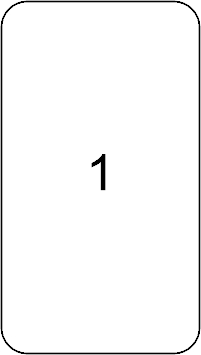
|
One spread you’ll find in almost every Tarot book ever written is the Single Card Draw. It works like this:
1.Pick a question.
2.Pick a card.
3.Relate the card to your question.
That’s it! The Single Card Draw works especially well with open-ended questions such as “What do I need to know today?”
Pro/Con or Yes/No
With your question in mind, draw two cards and place them side by side.
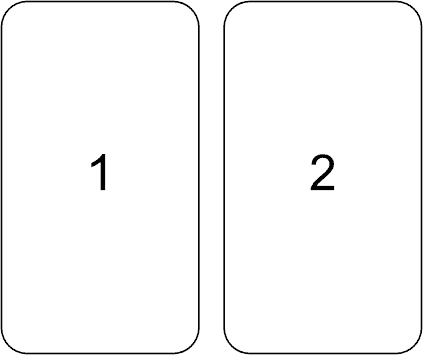
|
The first card represents why something should be done; the second card represents why something shouldn’t be done. You can learn more by drawing several pro and con cards and placing them into parallel columns.
The Crossroads Spread
The Crossroads spread explores the forces that create or perpetuate a situation. This spread is particularly good for conflict resolution because it can make it easier for you to understand a completely foreign point of view.
The two cards representing each viewpoint are laid one over the other, at right angles, creating a miniature intersection (or a “plus sign”).
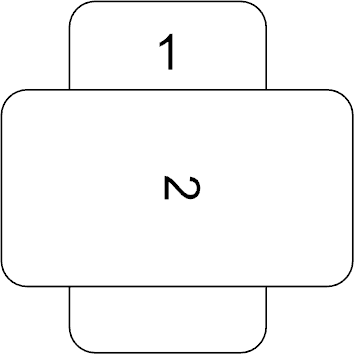
|
The top card represents one perspective on your problem; the other card represents another. As you relate each of these cards to the question under consideration, you’re likely to see your issue from a completely different point of view.
If you like, draw one to three additional cards, representing steps you can take that will transform the conflict into a win-win situation.
Past/Present/Future
This popular spread deals three cards into a straight line. Don’t be fooled by its apparent simplicity! This little spread can deliver amazing insight into the direction and evolution of your situation.
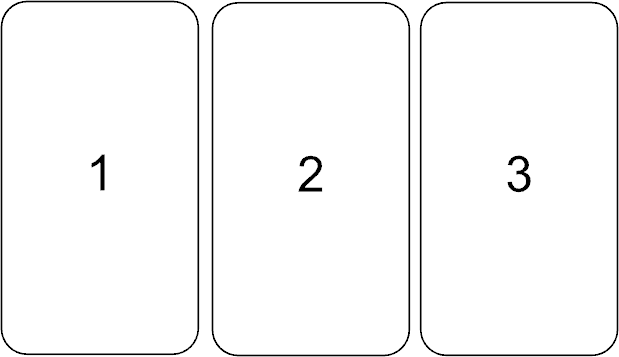
|
The cards, read from left to right, represent the past, present, and future. You can easily expand this spread by drawing multiple cards corresponding to many possible futures.
The Minor Cross
When you’re ready for readings with more depth, you can opt for a more complex spread, such as the Minor Cross. It’s especially useful when you need quick insights into a persistent problem that, despite the passage of time, continues to block your progress.
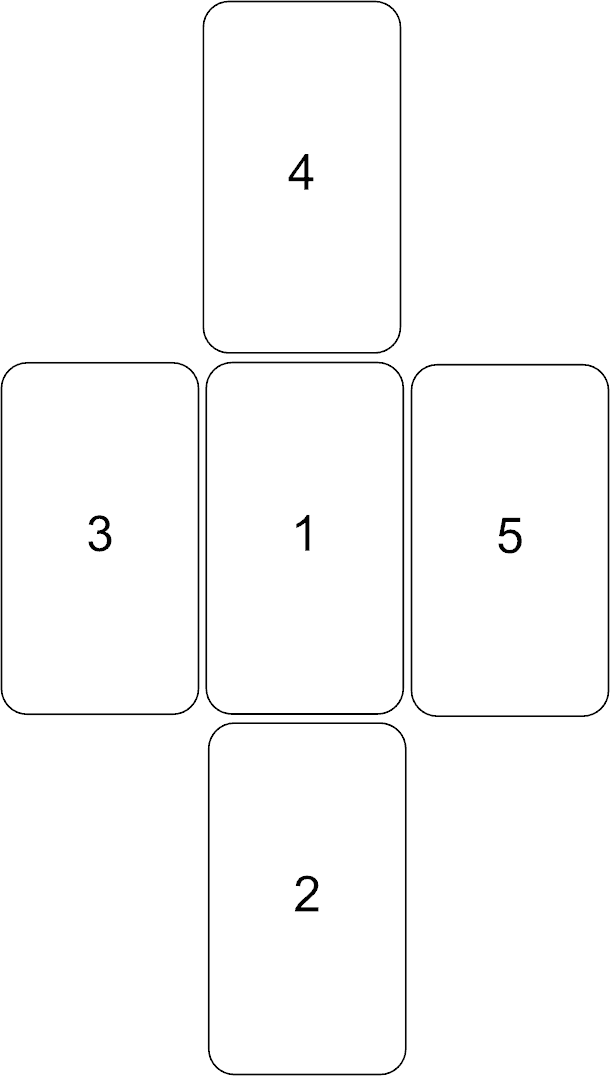
|
The positional meanings for the Minor Cross include
- Card One: The Situation—This card answers the question “What’s going on?”
- Card Two: The Foundation—This card represents the person or influence that perpetuates your situation.
- Card Three: The Past—This card reveals how the Foundation has shaped past events.
- Card Four: The Catalyst—The Catalyst represents potential for change, something that can be done to shake things up, change your luck, or redirect the flow of events.
- Card Five: The Result—This card represents the outcome, or what you can expect from putting the Catalyst into play.
The Story Spread
The Story Spread allows you to see your situation in terms of plot points in an ongoing story.
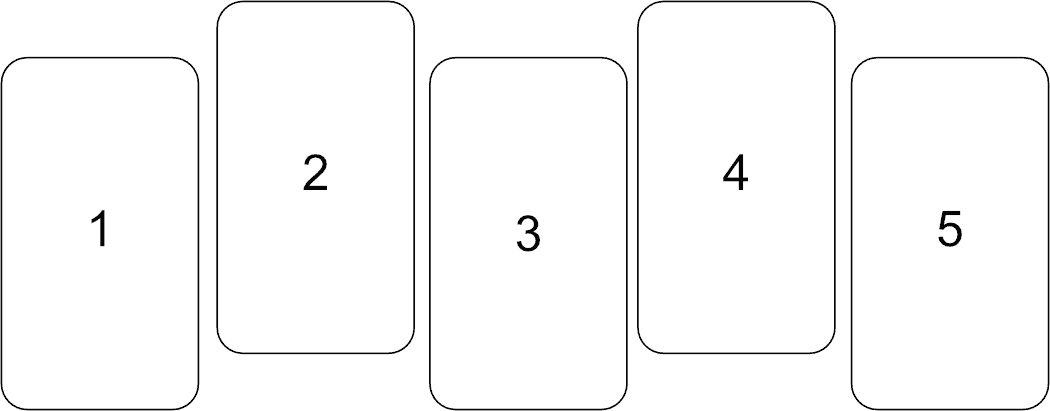
|
Positional meanings in the Story Spread include
- Card One: Once Upon a Time—This card represents your situation in the beginning, before complications occur. Expect to see your original goals or expectations reflected here.
- Card Two: The Incident—This card represents how an action taken, person met, or decision made changes the course of events forever.
- Card Three: Initial Response—When we encounter obstacles, we usually do our best to avoid them. This card reflects your first most basic, most impulsive response to the Incident.
- Card Four: Insight—This card reveals something you must know in order to act with wisdom.
- Card Five: Resolution—The Resolution points the way out of the forest, increasing your chances of living happily ever after.
The Story Spread is a particularly effective spread for working with relationship issues because it clarifies original intentions, identifies misunderstood or misinterpreted actions, and suggests a way to move forward.
Celtic Cross
What list of spreads would be complete without the Celtic Cross? This spread first appeared in A. E. Waite’s Pictorial Key to the Tarot. Over the years, readers have changed the positional meanings to suit their tastes. Still, Waite’s basic structure remains intact.
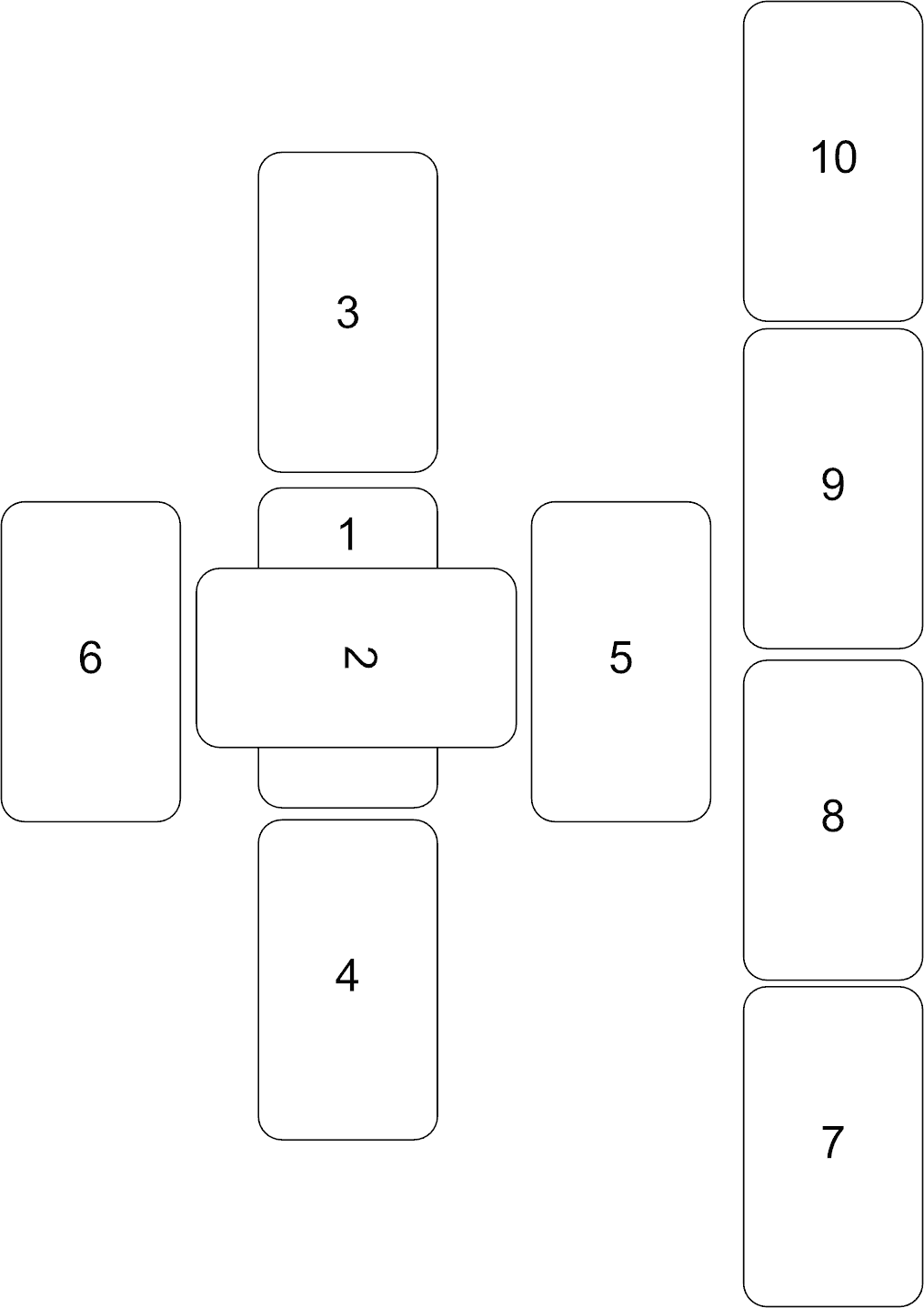
|
The positional meanings for the Celtic Cross are
- Card One: What Covers You—Represents you and your situation
- Card Two: What Crosses You—Indicates an influence now coming into play
- Card Three: What Crowns You—Represents your hopes and goals
- Card Four: What is beneath You—Symbolizes the issue at the root of your question
- Card Five: What is before You—Indicates an influence that will soon have impact
- Card Six: What is behind You—Represents your history
- Card Seven: You—Reveals your feelings about your situation
- Card Eight: Your House—Reveals the mood of those closest to you
- Card Nine: Your Fears—Illuminates your deepest concerns
- Card Ten: The Outcome—Reveals what will ultimately happen
Today’s Tarot readers often feel the positional meanings of the Celtic Cross are too fatalistic. If you agree, try these assignments for cards Seven through Ten:
- Card Seven: The Obstacle—Clarifies what the problem really is
- Card Eight: The Option—Offers a plan of action
- Card Nine: The Current Future—Reveals what will happen if you do nothing
- Card Ten: A Possible Future—Reveals what could happen if you take the Option
Custom Spreads
With time, you’ll create your own spreads. Remember, though, that spreads with fewer cards are easier to read. A simple line of three cards makes for an enormously flexible spread, capable of representing Past/Present/Future, Three Steps to Success, and hundreds of other possibilities.
If you being to feel that spreads confine or restrict your work with the cards, you might try a process described in Michele Morgan’s A Magical Course in Tarot. Morgan advocates randomly tossing a predetermined number of cards on the table, then exploring how the cards seem to relate to each other. (You might decide, for example, that cards falling closest to you represent forces with impact on your situation than cards falling farther away.) This freestyle approach produces the ultimate custom spread!
Performing the Reading
After you define your question and choose a spread, the reading process can begin.
Shuffling and Cutting the Deck
Practically speaking, the goal of shuffling and cutting is to randomize the cards, avoiding the presentation of the same cards over and over again. Mathematicians assert seven poker shuffles thoroughly randomize a deck.
Metaphysically, the goal of a shuffle and cut is to sample the moment and allow the cards to reflect the situation. In this case, you just shuffle until the cards feel right.
Generally, Tarot cards are shuffled in one of three ways:
Overhand shuffle. This allows cards to slip gently over each other.
Finger-painting method. This is good for large decks because it spreads cards into a messy tabletop pile and then squares them up again.
Over-the-bridge or poker shuffle. This mixes cards rapidly and well. Many readers use this method, but some frown on it, fretting that it looks disrespectful. On a more practical note, you should also be aware that a poker shuffle is much more likely to bend your cards or fray their edges—vastly reducing the life of your deck.
Cutting the cards is traditionally done with the left hand (the hand of intuition), dividing the deck into two or three roughly equal piles before reassembling it. You can honor these traditions or blaze trails of your own.
Dealing the Cards
As you deal, you must decide whether you prefer to place cards face-up or face-down. You must also have a strategy for dealing with cards that have become inverted (or reversed) by the shuffling process.
Face Up or Face Down?
Dealing the cards face down allows you to reveal them one by one. This adds drama to a reading and allows you to track your progress through the reading, card by card.
Face-up cards can be analyzed quickly before the formal reading begins, letting you count the number of trumps present, for example.
Try both methods, and then embrace the one that suits your purposes.
Handling Reversals
When a deck is shuffled, some cards turn upside-down, creating reversed cards. Some readers ignore reversals, turning the cards upright and moving on. Other readers allow reversals to alter card meanings in various ways:
Opposition. Whatever a card means, a reversal means the opposite. The reversed Death card, for example, might foretell a birth.
Restriction. The forces represented by the card are being repressed or held back. A reversed Three of Cups, for example, might mean someone feels joy (one meaning for the card) but hides it.
Blockage. The forces represented by a card are present, but some obstacle restricts your access to them.
Try some readings with reversals and some without—but each time you read, decide before you deal.
Tip: You can encourage reversed cards during the cutting process. Split the deck in two, reverse one half, and shuffle the halves together.
Interpreting the Cards
Some readers are intuitive, going with the flow; others are analytical, using well-defined systems to generate meanings. Many readers blend intuitive and analytical methods to produce their own unique reading styles. As part of coming up with your own technique, give the following approaches a try.
Intuitive Methods
An intuitive reader favors his or her impression of a card’s meaning over any meaning supplied in a book. Intuitive methods draw on free association, past experiences, gut feelings, leaps of logic, memories, flashes of insight, or psychic abilities to define deeply personal meanings for each card.
The Card Story
Humans see stories everywhere: causes and effects, beginnings and endings.
The card story method takes advantage of this ability. Give it a try: what story is being told by this line of three cards?

|

|

|
One person might see the story of an overburdened worker (Ten of Wands) who, in order to restore balance in his life (Temperance), leaves corporate life behind (Six of Swords). You might see something else entirely—the point is to tell a story.
When working with this method, pay close attention to detail. Note expressions and postures. Are characters looking at each other or ignoring each other? Does a figure on one card seem to point to another? As you analyze what’s going on, you’ll find that the story you uncover contains the advice you need most.
Images and Actions
This simple method involves translating each card into an action plan. Perhaps you want something different to do this weekend. What actions might be suggested by these cards?

|

|

|
The Chariot might make you think of a car and, by extension, a road trip. Associating the Five of Coins with poverty, you might volunteer at a local shelter. An image of eight swift, flying Wands might suggest the idea of speed, sending you out to the local go-kart track.
Want to supercharge this method? Generate more than one option for each card.
Single Card, Single Item
It doesn’t get much simpler than this: Ask a question, draw a card, identify the very first card element that catches your attention, and free associate!
Let’s say your question is, “What should I do about that co-worker who keeps stealing my best pens?” With your question in mind, take a look at this card:

|
Let’s say the wands themselves catch your eye. They look a bit like pens, don’t they?
Having made this association, you might be inspired to see the Five of Wands as an image of five men fighting with (or perhaps fighting over) pens. This might, in turn, lead you to realize that declaring war over pens is a pretty silly thing to do. Based on that realization, you might decide to simply give your co-worker a box of pens—or decide to stop worrying so much about life life’s little annoyances.
Ask a Good Question
Stoke your intuition by asking open-ended questions, such as these:
- If this picture were a coded message, what would the message be?
- If the character on this card could talk, what would he or she say?
- What’s the mood of the card? What emotions do I associate with it?
- If the card characters moved, what would happen next?
Analytical Methods
Analytical readers depend on keywords, suit and number symbolism, divinatory meanings, and other systems when coming up with meanings for the cards. Adopting analytical methods will quickly build your skills.
Noting Card Types
Simply put, in this method you determine what you can learn from the type of cards that appear in the reading. Consider, for example, this line of cards:

|

|

|
The fact that this line of cards contains two court cards and one trump can reveal a great deal.
Before responding to the images, consider what type of cards are in this spread. There are two court cards in the outermost positions. Might this suggest there are two people at odds with each other? The center card is a Major Arcana card; might their apparent differences reflect a larger design?
Counting Reversals
How many reversals are there? One or two reversals might be considered par for the course, but take note when the majority of cards are reversed. This can often indicate a stalemate of some kind or a situation in which people are refusing to say what they think.
Reading Simple Elementals
Reading simple elementals is easy. In any spread with at least three cards, count how many cards come from each of the four suits. Does one suit dominate? Is one suit absent? Here are some quick and easy guidelines for assigning meaning to the dominance or absence of a specific suit:
- Wands
- If dominant: fiery energy; conflicting goals; hyperactivity; emphasis on action
- If absent: Difficulty making things happen or action with no real goal in mind
- Cups
- If dominant: emotionalism; emphasis on collaboration and feelings; introspection
- If absent: clinical detachment; action with no thought of impact; coldness
- Swords
- If dominant: emphasis on logic; paralysis by analysis; over-thinking
- If absent: lack of communication; impulsive action; irrationality; confusion
- Coins
- If dominant: practical concerns; emphasis on cost, value, health, and body
- If absent: impracticality; no eye on the bottom line; unhealthy choices
Given the following line of cards, what conclusions might you draw?

|

|

|
Clearly, Cups dominate, indicating a highly emotional situation. In addition, Wands (the fiery suit of intention) and Swords (the airy suit of intellect and logic) are missing. As a result, before interpreting individual cards, you would know this reading concerns an emotionally charged incident that, in addition to bringing matters to a standstill, confuses everyone involved.
Reading Numbers
Which numbers appear on the cards? If the cards are arranged in a straight line, do the numbers increase? Decrease? Balance each other? What might the numbers suggest about changes in intensity over time?
Consulting a Reference
The reference guide in this book provides basic keywords and meanings for each card. For a more comprehensive guide, please consider my own A Guide to Tarot Card Meanings, which provides detailed keywords, questions, and useful insights into the meaning of every card in a conventional 78-card deck.
Rather than be enslaved by any reference guide, make it work for you. Are the meanings helpful? If so, adopt them. If not, ignore them.
Ending the Reading
When your reading is complete, note your insights and return the cards to the deck. If you enjoy rituals, you may wish to do one or more of the following:
- Clear the deck by fanning it and restacking it.
- Say a short prayer of thanks.
- Rewrap the deck in a silk cloth before storing it.
If you aren’t into rituals, simply collect your cards and put them away.
A Sample Reading
Troy, Rita’s best friend, recently began dating JoAnn, a woman he met at work. Rita and Troy’s other friends want to make JoAnn feel included. Unfortunately, JoAnn’s sense of humor makes getting along with her a challenge. (She enjoys making fun of others.) Worse, whenever she’s around, she constantly complains that Troy spends too much time with his friends.
Troy seems oblivious to JoAnn’s shortcomings. Rita, at the end of her rope, is on the verge of telling Troy, “It’s time to choose between JoAnn and your friends.” Before she delivers the ultimatum, she turns to the Tarot.
Preparing for the Reading
Once home from work, Rita turns off her phone to limit distractions. To set the mood, she plays her favorite meditation music and lights her Tarot reading candle.
After retrieving her favorite deck from an ornate wooden box, she places the deck on the table and pauses to gaze at the candle flame—her personal ritual for clearing her mind. Once she feels her shoulders relax, she thumbs through the deck, auditioning significators. Ultimately, she decides the following:
- Troy will be the Page of Wands. “Pages are beginners, and I associate Wands with sexuality and passion,” she says. “This is Troy’s first serious relationship in a long time.”
- JoAnn will be the Queen of Cups. “I associate Queens with subtle control and Cups with emotions. JoAnn knows exactly what she’s doing, using emotions to get her way.”
- Rita will be the Queen of Swords. “I like to think of myself as the Queen of Swords, using my wits to control things from behind the scenes.”
With significators picked and returned to the deck, Rita picks up a pad and pen. After drafting several questions, she eventually decides on the following question: “What can I do to help Troy understand how JoAnn is affecting his friendships?”
Before shuffling and dealing the deck, Rita adapts the Minor Cross spread to suit her needs, drawing rectangles on her pad to represent the position of each card.

|
Before dealing the cards, Rita creates a spread and assigns meanings to each position. She decides on the following positional meanings:
- Card One: The Situation. The card here will amount to a photograph of what’s going on.
- Card Two: The Unseen. Rita likes to include this card as a way of shattering her assumptions and taking off her blinders.
- Card Three: The Other. Rita hopes this card will provide insights into JoAnn’s point of view because, she says, “I don’t have a clue what that woman is thinking.”
- Card Four: The Action. Rita wants this card to represent something she can do to communicate her unhappiness.
- Card Five: The Result. This card will give Rita some indication of what will happen if she puts The Action into play.
Performing the Reading
Rita picks up her Tarot deck and, with her question in mind, gently shuffles the cards until she feels satisfied. With her left hand, she cuts the cards three times. When she reassembles the deck, she deals the first five cards off the top into the positions she defined earlier.
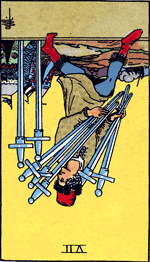
|
||

|
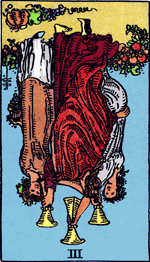
|

|

|
Rita receives the following cards:
- Card One: The Situation—Three of Cups, Reversed
- Card Two: The Unseen—Page of Wands
- Card Three: The Other—Six of Wands, Reversed
- Card Four: The Action—Seven of Swords, Reversed
- Card Five: The Result—Temperance
Rita prefers to begin her readings with analytical approaches, looking for trumps, taking note of which suits are represented, and recalling her favorite keywords for each card. Today, she notices the suit of Wands dominates, which suggests this is a reading about conflicting desires. She notices the suit of Coins is completely absent, suggesting that she would likely feel better if she paused to consider the matter from a more practical (Coins) point of view.
Three out of five cards are reversed. Long ago, Rita decided to associate reversed cards with restrained energy. The three reversals hint that the people involved in the situation are repressing their feelings instead of speaking their minds.
Finally, she notices the spread contains only one trump: Trump XIV, Temperance. Because the other cards are from the Minor Arcana, she feels encouraged that this is a situation that falls within the realm of everyday life—something she and her friends can handle.
Her overview completed, Rita focuses on individual cards and allows her intuition to guide her interpretation of each one:
The Situation. Rita begins with Card One, the Three of Cups. Years ago, she memorized the keyword celebration for this card. Today, though, the picture on the card brings to mind her circle of friends. To Rita, the reversal suggests that JoAnn’s arrival has upset or overturned her group’s friendly alliance. “Normally, we’re all as close as can be, but with JoAnn on the scene, we’re doing more grumbling than laughing.”
The Unseen. The appearance of the Page of Wands, Troy’s significator, gives Rita pause. “This suggests to me that Troy plays a role I’m overlooking.” After a pause, she experiences a sudden insight. “We’re blaming everything on Rita, but the fact is that Troy’s around when all of this is going on. He’s got to be aware of it, but he’s choosing not to do anything about it.” She shakes her head. “Until now, it hadn’t occurred to me that Troy’s part in all of this is just as important as JoAnn’s.”
The Other. Rita normally associates the Six of Wands with victory or success, but here, the card is reversed. “This card represents JoAnn’s perspective. I’m guessing it means that she feels like she’s in a competition for Troy’s attention and, because it’s reversed, she probably feels like my friends and I are winning.”
The Action. The figure on the Seven of Swords always strikes Rita as sneaky. In addition to logic and decision-making, Rita associates Swords with communication; she also sees seven as the number of imagination. “Put those two meanings together, and you get imaginary communication, such as rumors and gossip. Because this card is reversed, I’m going to say the recommended action is stop the gossip and have a frank talk with Troy.”
The Result. Rita was encouraged by the Result card. “Temperance is all about finding middle ground. If I play my cards right, there’s a good chance I can avoid extremes and bring all of this to a great conclusion.”
Thankful for her insights, Rita pauses to say a quick invocation to the Goddess. She notes the cards and her interpretations in her Tarot Journal, returns the cards to the deck, fans out the deck to clear away the energy associated with this reading, and returns the deck to its wooden box.
In a Nutshell
- Prepare for a reading by preparing your space and your deck in ways that make sense to you. Before dealing the cards, define your question clearly, decide whether to use significators, and select an appropriate spread.
- Shuffle and cut the cards in any way that seems effective; then deal them.
- Read the cards, employing any intuitive or analytical methods that work for you.
- When your reading is complete, perform a ritual of your choice (or none at all, if you prefer) and store your cards appropriately.